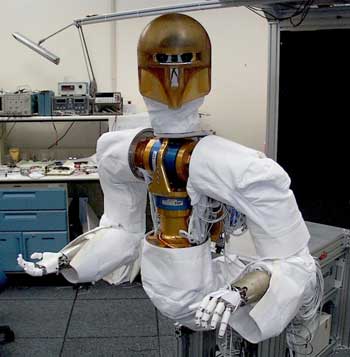NASA is working on developing an astronaut robot that can assist human astronaut teams
Press release from NASA

Human hands and fingers, a TV camera as eyes - these are the organs of NASA's Robonaut. Now scientists are working on giving wheels and legs, or at least one leg, to the easy-to-move robot.
The Robonaut took its first steps recently during experiments at the Johnson Space Center in Houston with the help of a unit "space leg", which it uses to move outside the simulation of a space station. Additional tests placed the humanoid robot on wheels, on a Segway for accuracy, and let it go.
Wheeled or with a space leg, the robonaut's head, back, arms and mechanical hands retained their ability to use space tools much like humans. In the tests, in which the robot moves with its space leg, the Robonaut looks like a futuristic construction worker outside a simulated spaceship. With the help of the Segway's wheels, which are stabilized with the help of gyroscopes, the Robonaut floated from one experimental station to another, as one day its descendants may do on the moon or Mars.
The tests of the leg confirmed the fact that the Robonaut will be able to climb the outer side of a spacecraft with the help of handles, while positioning its leg at a certain work site to make repairs or install parts. NASA's goal is to build robots that can "live" on the outer side of spacecraft and be prepared for routine maintenance or emergencies. Humans inside the spacecraft will operate the Robonaut using wireless control.
The experiments with the wheels provided initial proof of the possibility of a "planetary centaur", a combination of humanoid robots and space rovers. In these tests, the Robonaut was placed on a Segway robotic mobility platform. They demonstrated that one operator can simultaneously control the robot's movement and skills using a wireless control system.
The type tests were an important step in the development of the Robonaut. They demonstrated the system's ability to climb, stabilize and handle tools and devices of extravehicular activity in the space environment. The test featured a battery-powered wireless Robonaut system, located on top of a hovercraft that floats on an air cushion, to eliminate the effects of friction and mimic the feeling of working in weightlessness. The Robonaut climbed with the help of railings for off-vehicle activity and connected its stabilizing "space leg" to a standard fixation socket of the space station (WIF - Worksite Interface Fixture), while its operators moved the Robonaut's limbs with the help of innovative controllers.
"The tests provided proof that the Robonaut can be manipulated with the help of an interchangeable base for various stabilization and movement purposes - and all this is done in a frictionless environment similar to space," said the director of the tests, Dr. Robert Ambrose of the Automation, Robotics and Imaging Department of the Johnson Space Center of NASA. "All the features I have mentioned are necessary for the future development of 'extra-vehicle activity units', which combine the skills of both humans and robots to significantly improve the efficiency of spacewalks."
The Robonaut project, which Ambrose leads, is a joint operation with the Defense Advanced Research Projects Agency (DARPA). It has been in development at the Johnson Space Center for several years. Two Robonauts were built, each with highly skilled hands that can work with the same tools that humans work with. The robot operators remotely control the movements of the robotnauts' heads, limbs, hands and two cameras using a combination of virtual reality interfaces and verbal commands, which are transmitted through special cables or wireless systems.
To move in a low-gravity environment, the robot must know how to climb by itself with the help of gaits, which gently control its momentum and minimize contact forces on the one hand, but provide safety in emergencies on the other. To gain access to jobs aboard the International Space Station and future spacecraft, the robots must manage with human-adapted spacewalking aids, such as straps, cleats and hooks.
"The tests went very well," said Ambrose. "The Robonaut team learned which climbing maneuvers are more applicable than others and tested autonomous software responses using the robot's force sensors. We have also identified new possibilities for using these sensors in semi-autonomous situations, which will help the robotonaut operators to deal with short delays (of one second to 10 seconds). Our team will continue to face these challenges, while NASA will continue to strive to implement interactions between humans and robots in missions related to returning to the moon and reaching Mars."
translating:
More information about the Robonauts:
